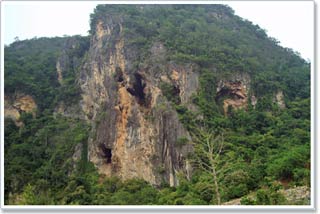Ancient pandas and monkeys used to compete for food
New fossils discovered that half a million years ago pandas and ancient monkeys had to compete for shelter and food in the southern coast of China.
According to Huang Wanbo, a paleontologist at Beijing's Anthropological Institute of Anthropology and Ancient Anthropology, a 400,000-year-old fossil of a giant panda was discovered along with the rest of an ancient monkey species Gigantopithecus. blacki .
Excavated from a limestone cave on an island in Hainan Province, fossils show that both pandas and Giganto monkeys have a common menu of bamboo and bamboo. 400,000 years ago, Hainan Island was a mountainous hilly peninsula and grew a lot of bamboo and bamboo. Today, the island is about 25 km from the mainland.
Survival war
Russell Ciochon, a professor at the University of Iowa who participated in many archaeological studies in China, though not including archeology in Hainan Island, said that the findings provide more knowledge about giant monkey homestays. Giganto is up to 3m tall, 'the largest monkey ever appeared on earth.'

A limestone cave on an island in Hainan Province, fossils show that both pandas and ancient monkeys have a common menu of bamboo and bamboo.(Photo: National Geographic)
The Giganto monkey extinct 300,000 years ago, after about half a million years of living with primitive humans. Huang thinks this monkey disappeared in the struggle for shelter, food with pandas and humans.
Panda fossils are found near the Giganto fossils and Chinese fossils have been discovered around ancient pandas.
If primitive people armed with weapons from stone axes and fire, migrating through southern China today are similar to pandas, they may have encountered this giant monkey. Fossils of primitive human species of Beijing or Homo erectus are found near Beijing in northern China about 2,000 km north of Hainan.
Ciochon said he used to think that Giganto was the first loser in the survival war with pandas and humans, but now he is no longer sure.'Pandas and Giganto live side by side in subtropical forests and compete for food sources but Homo erectus can also live in another area.'
Archaeologists have not yet found the Homo erectus fossil in southern China, but they have not yet explored the entire area.
Survival of pandas
Huang said that Hainan panda fossil revealed more information about the evolution of this species 8 million years from predators to bamboo.
According to scientists, the pandas began as a fierce carnivore. Today, pandas are animals that eat plants and they can spend up to 12 hours a day to eat stems and leaves. New fossils revealed 400,000 years ago, pandas are not much bigger than today and at the time they were fully dependent on bamboo.
Huang said that pandas are often hunted for their skin and fur, which also happened to its ancestors hundreds of thousands of years ago.'400,000 years ago, more pandas than humans.' According to nature conservationists in China, China's population has reached 1.3 billion while pandas have reduced to about 1,600.
China began collaborating with international conservationists to save the animal when a government investigation reported an alarming 1,100 numbers. Fan Zhiyong, conservation program director of the nonprofit organization WWF in China, said: The number of pandas has plummeted due to large-scale human activities such as road construction, dams, mining, tourism, logging and hunting.
Conservationists have mentioned a number of measures to save the pandas from extinction such as turning panda hunting into crimes, establishing a system of panda sanctuaries at the foot of the Himalayan mountain in western China and conducting Promote reproduction for captive pandas.
Currently, paleontologist Huang has proposed establishing the panda's DNA data system to establish the evolutionary history of pandas. Huang thinks that discovering the secret of panda genes in the past could be a key to protecting the future of this animal.
- Bunch of super funny pandas
- Find out the ancient giant panda DNA
- Add two new species of 'gibbon and monkey' to the evolutionary tree
- Monkeys beams 'stuffy nose' strange
- Surprise with the favorite dish of the ancient people
- Giant pandas may originate from Europe
- Do pandas not be caused by climate change?
- Strangely the monkey has a long nose and mimics like a cow
- Video: The way to flirt with a strange capuchin monkey
- The extremely rare trio of successful pandas
- Pandas are welcome as 'stars' in Australia
- 1600 pandas face threats from horses
 Discovered an ancient centipede fossil 99 million years old
Discovered an ancient centipede fossil 99 million years old Discovered bat-like dinosaurs in China
Discovered bat-like dinosaurs in China Discovered a 200-year-old bronze cannon of the coast
Discovered a 200-year-old bronze cannon of the coast Discover 305 million-year-old spider fossils
Discover 305 million-year-old spider fossils